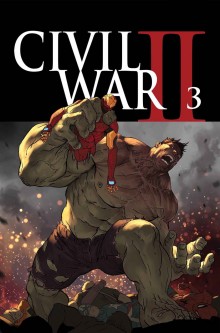 Home > CR Reviews
Home > CR Reviews Civil War 2 #1-3
posted July 27, 2016
Civil War 2 #1-3
posted July 27, 2016

 Creators:
Creators: Brian Michael Bendis, David Marquez, Olivier Coipel, Justin Ponsor
Ordering Information: Marvel, comic books, 44 pages, 2016, $4.99 each.
Availability: Comic Shops Nationwide
Let's get the caveats out of the way first. I've liked the Brian Michael Bendis-written comic books I've read in the past. The art team for these comics of David Marquez and Justin Ponsor seems well-suited to what Marvel's
Civil War 2 asks them to do, even if it's not particularly distinctive to someone not immersed in that world. I have fun reading superhero event series. In an era where the Direct Market seems dominated by patrons looking to be told what's important and vital to buy, crossover titles do that more directly than any other comics on the stands. Sitting down with this small pile of comic books, I was ready to enjoy myself and discover some insight as to how modern series work, what's important to company and creators at this particular time, and maybe see some cool fights and witty interplay.
Then I read the issues.
I'm still not sure what the heck happened, but I didn't have much fun, and I'm an easy mark. Plus now I'm confused as well.
In this rehash of the mega-successful
Civil War series of 2006 into 2007, the various Marvel heroes on the 41 different Avengers teams have to decide how and if to make use of a precognitive Inhuman recently unearthed by that Jack Kirby (with Stan Lee) creation's Royal Family, the Inhumans fully present in their strange, modern role as X-Men with better movie deals. (The Inhuman in question, Ulysses, looks like a 2005 parody of a Portland barista. He's a student at Ohio State, so okay, I'll give them that one.)
Instead of Iron Man vs. Captain America, this time it's Iron Man vs. Captain Marvel: great for the latter character's relative gravitas but so far not as iconically satisfying as the two geezer-pals coming to blows. Instead of everyone fighting everyone, the actors playing significant roles in
Civil War 2 stand around and talk -- at least so far. Conflict is either over quickly, told in flashback form, projected or thwarted. That could be part of the point, too, I don't know. It makes for a pretty dull ride. Even the dialogue never gets much further than people declaring first motivations at each other, Internet-style.
Sometimes I think all of modern comics can be explained in that one
Avengers annual Jim Starlin did in the mid-'70s when they go off into space to fight Thanos, back when travel converns weren't automatically circumvented in superhero plotlines. Three to four pages of that issue is thus given over to the various heroes brooding and contemplating this forthcoming battle as they move towards it. If like me as an eight-year-old you preferred the Council of Elrond to the Battle of Helm's Deep, this was an amazing thing. There was a time when a significant subset of superhero readers would occasionally verbalize their desire to have their favorites just sit around and talk, as if every other kind of comic weren't more suitable for that, to greater reward.
Can you do whole issues with the Avengers on a quinjet, brooding? Whole series? Is this a slow build to something or is this the something? Are readers that invested in incremental soap opera based on abstract ideas of genre filtered through broad approaches to what the future means? The words used to create the series' slogans fail to achieve the clarity the previous series' register/don't register paradigm enjoyed. I still don't know which side is protecting and which side is saving the future. I might never find out. In the three issues I read, there are barely sides. Is
that the point? As walking metaphors, superheroes will support just about any reading, but that doesn't make the readings any more pleasurable or insightful, except maybe in an accidental way: the choice of victim, who is deferential to whom. At that point it becomes
about the genre, which was only ever half of the 1960s Marvel formula.
It may be through fiat-favoring sprawl that this particular comic series in its entirety is what used to be the 3-4 pages of an old annual's subplot, and the fighting and meaning-making has all been moved into the supporting series. At some point -- I remember first thinking this around the time of
Final Crisis, which read much better with its
Superman series sewn into its body -- mainstream comics companies became happy to sell you a clearly lesser version of the story in the hopes your buying habits might migrate in an unconscious search for a more complete version. It's a strategy that rewards smart readers and punishes your competitors. It's a strategy that thwarts art.
It's difficult for me to trust modern entertainment that conceals its best parts in an attempt to extend the amount of money they're asking you to spend. The longer versions of Peter Jackson's boys-adventure
Lord Of The Rings movies were an exception that proved the rule, and for those to work that way they had to utilize Academy Award-nominated material as the "less satisfying" components. Now we get this idea regularly, like with that horrible
Batman vs. Superman film, a time-lapse of a bruise being formed, showing up with its hand out 90 days after spitting on your palm. Who has the time to keep up? I do this for a living and I don't.
Some days with comics I feel like I'm buying Wonka bars, hoping I got one of the ones with the plot in it. If this is the future, I vote reject it.



